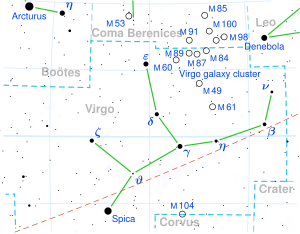| Observation data Epoch J2000.0 Equinox J2000.0 | |
|---|---|
| Constellation | Virgo |
| Right ascension | 13h 09m 56.99067s [1] |
| Declination | −05° 32′ 20.4185″ [1] |
| Apparent magnitude (V) | 4.37 [2] (4.49 + 6.83 + 9.4 + 10.4) [3] |
| Characteristics | |
| Spectral type | A1Vs [4] + ? + A9m + ? [3] |
| U−B color index | +0.00 [2] |
| B−V color index | −0.02 [2] |
| Astrometry | |
| Radial velocity (Rv) | −2.9 [5] km/s |
| Proper motion (μ) |
RA: −36.28
[1]
mas/
yr Dec.: −31.22 [1] mas/ yr |
| Parallax (π) | 10.33 ± 1.09 mas [1] |
| Distance | approx. 320
ly (approx. 100 pc) |
| Absolute magnitude (MV) | −0.52 [6] |
| Details | |
| θ Vir Aa | |
| Mass | 3.11±0.11 [7] M☉ |
| Luminosity | 190 [7] L☉ |
| Surface gravity (log g) | 3.4 [4] cgs |
| Temperature | 9,250 [4] K |
| Rotational velocity (v sin i) | 4±1 [4] km/s |
| Other designations | |
| Database references | |
| SIMBAD | data |
Theta Virginis (θ Vir, θ Virginis) is a multiple star system in the zodiac constellation of Virgo. Based upon parallax measurements, it is about 320 light years from the Sun. The three [9] stars in this system have a combined apparent visual magnitude of 4.37, [2] bright enough to be seen with the naked eye.
The primary component, Theta Virginis Aa, is a white-hued A-type main sequence star with a stellar classification of A1Vs. [4] It is part of a spectroscopic binary [10] whose components, Aa and Ab, have visual magnitudes of +4.49 and +6.83 respectively. The system has an orbital period of about 33.04 years with an eccentricity of 0.9. [3] The brighter member of this pair shows photometric and radial velocity periodicities with a cycle time of 0.7 days, which may indicate its rotation period. [11]
The inner pair is orbited by the 9.4 magnitude B component, at an angular separation of 7.1 arcseconds. A fourth component C, 69.6 arcseconds away, has an apparent magnitude of 10.4. [3] However, component C is an optical companion: it is physically unrelated and only appears close in the sky. [9]
References
- ^ a b c d e van Leeuwen, F. (2007), "Validation of the new Hipparcos reduction", Astronomy and Astrophysics, 474 (2): 653–664, arXiv: 0708.1752, Bibcode: 2007A&A...474..653V, doi: 10.1051/0004-6361:20078357, S2CID 18759600.
- ^ a b c d Mermilliod, J.-C. (1986), "Compilation of Eggen's UBV data, transformed to UBV (unpublished)", Catalogue of Eggen's UBV Data, SIMBAD, Bibcode: 1986EgUBV........0M.
- ^ a b c d Eggleton, P. P.; Tokovinin, A. A. (September 2008), "A catalogue of multiplicity among bright stellar systems", Monthly Notices of the Royal Astronomical Society, 389 (2): 869–879, arXiv: 0806.2878, Bibcode: 2008MNRAS.389..869E, doi: 10.1111/j.1365-2966.2008.13596.x, S2CID 14878976.
- ^ a b c d e Landstreet, J. D.; et al. (September 2009), "Atmospheric velocity fields in tepid main sequence stars", Astronomy and Astrophysics, 503 (3): 973–984, arXiv: 0906.3824, Bibcode: 2009A&A...503..973L, doi: 10.1051/0004-6361/200912083, S2CID 53423301.
- ^ Wilson, R. E. (1953), "General Catalogue of Stellar Radial Velocities", Carnegie Institute Washington D.C. Publication, Carnegie Institute of Washington, D.C., Bibcode: 1953GCRV..C......0W.
- ^ Anderson, E.; Francis, Ch. (2012), "XHIP: An extended hipparcos compilation", Astronomy Letters, 38 (5): 331, arXiv: 1108.4971, Bibcode: 2012AstL...38..331A, doi: 10.1134/S1063773712050015, S2CID 119257644.
- ^ a b Zorec, J.; Royer, F. (January 2012), "Rotational velocities of A-type stars. IV. Evolution of rotational velocities", Astronomy & Astrophysics, 537: A120, arXiv: 1201.2052, Bibcode: 2012A&A...537A.120Z, doi: 10.1051/0004-6361/201117691, S2CID 55586789.
-
^
"tet Vir".
SIMBAD.
Centre de données astronomiques de Strasbourg. Retrieved 2016-09-05.
{{ cite web}}: CS1 maint: postscript ( link) - ^ a b Tokovinin, Andrei (2018). "The Updated Multiple Star Catalog". The Astrophysical Journal Supplement Series. 235 (1): 6. arXiv: 1712.04750. Bibcode: 2018ApJS..235....6T. doi: 10.3847/1538-4365/aaa1a5. S2CID 119047709.
- ^ Adelman, Saul J. (November 1997), "On the possible variability of the main sequence A stars theta Virginis and 109 Virginis", Astronomy & Astrophysics Supplement Series, 125 (3): 497–499, Bibcode: 1997A&AS..125..497A, doi: 10.1051/aas:1997105.
- ^ Scholz, G.; et al. (September 1998), "Spectroscopic and photometric investigations of MAIA candidate stars", Astronomy and Astrophysics, 337: 447–459, Bibcode: 1998A&A...337..447S.
External links
- Kaler, James B., "Theta Virginis", Stars, University of Illinois, retrieved 2016-09-08.
- Plotner, Tammy; Vogt, Ken (2009), The Night Sky Companion: A Yearly Guide to Sky-Watching 2009, The Patrick Moore Practical Astronomy Series, Springer Science & Business Media, p. 172, ISBN 978-0387795096.
